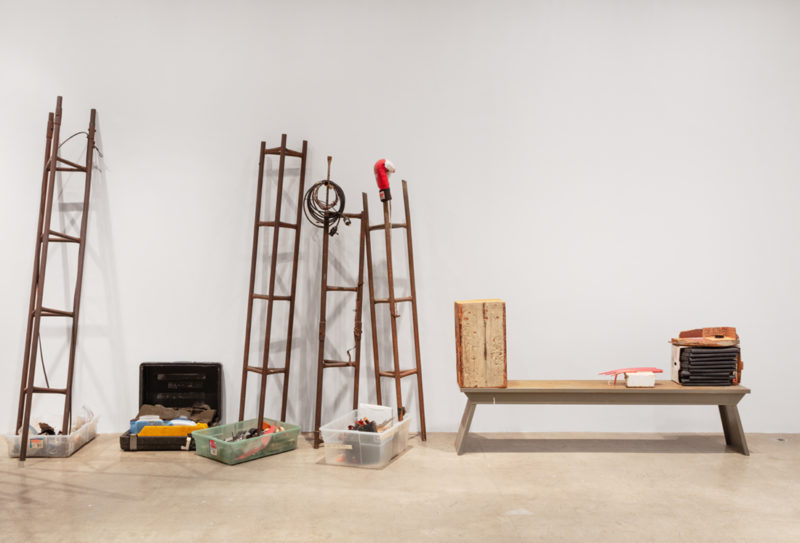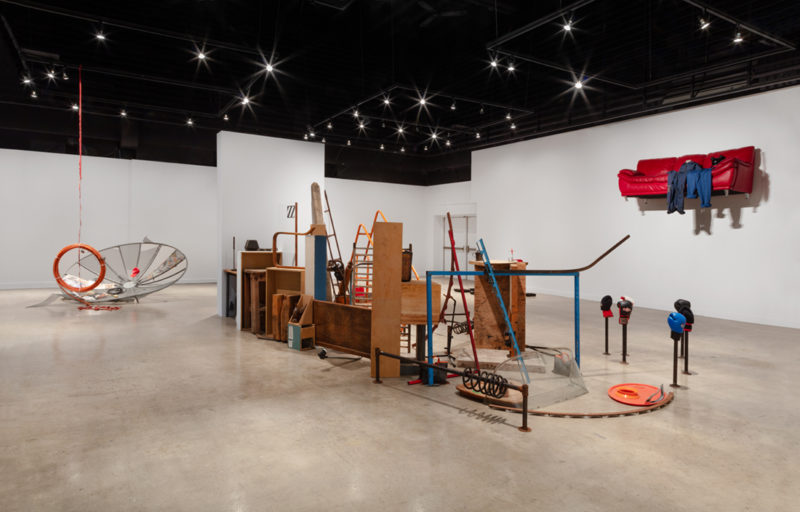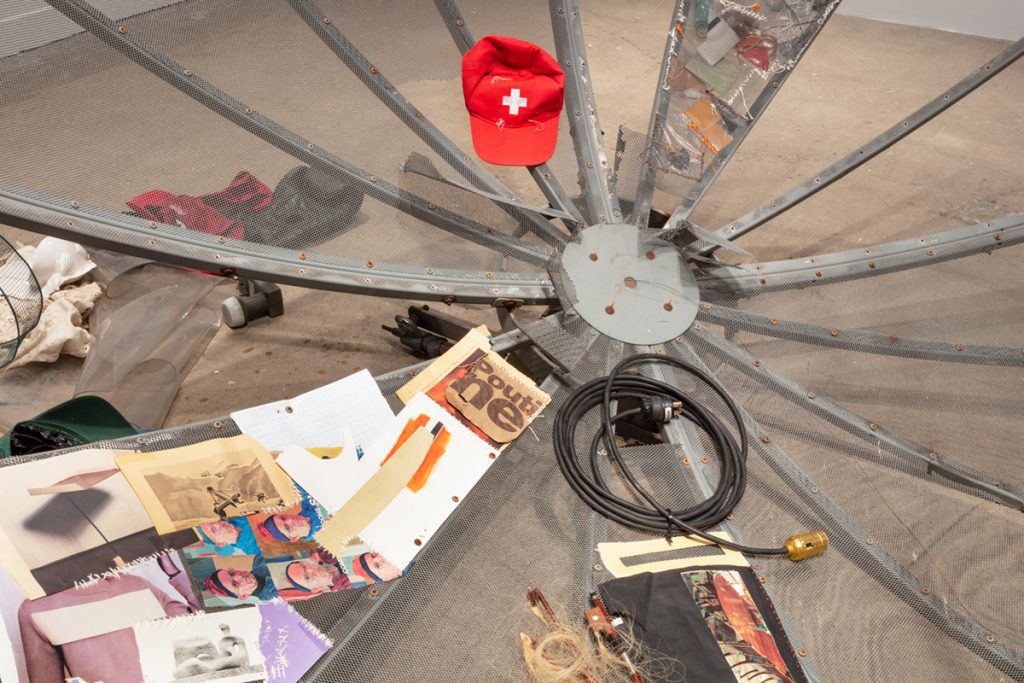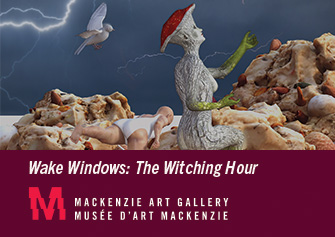Snail Inventory Sheet: Georgia Dickie at Oakville Galleries
14 April 2020
By Kate Kolberg
As I walked through Agouti Sky, Georgia Dickie’s solo exhibition at Oakville Galleries, I kept hearing my dad’s voice in my head. “Let’s see what’s in inventory,” the phrase he habitually announces before hastening off to his basement workshop to find something. Though my father would argue otherwise, the room is shambolic, muddled with tools, his exercise bike and innumerable things. These things are of some mysterious origin, known only to him, and they’ve been saved as “inventory” for moments just like this—the moment when “this might come in handy” is realized. So, as I came face-to-face with Dickie’s most conspicuous, centrally-placed piece, Reef (2019), a multi-part installation of found objects, my mind began swanning through the familiarity of it all: this was an inventory. Reef, in sum with the eleven other sculptural works in the show, is an assemblage of items: wooden boxes, satellite dishes, a leather belt, metal frames, cash registers, metal wiring, a tensor bandage, tubing, ropes, cut paper, candles and a baby seat. A jumbled group of things, with some mysterious origin, known only to her.
In the years I’ve observed Dickie’s practice, I’ve come to think that she must share the same methodology as my favourite sea creature: the xenophoridae, or, as it’s more commonly known, the carrier shell. The xenophoridae, a type of sea snail, collects small stones and shells as it travels along the ocean floor, periodically cementing them to its own shell as it grows. Similar to the personalities and styles of people, their appearances range from tame to eccentric; some xenophoridae choose to affix small, unremarkable stones to their back, while others place outlandishly large pieces of coral that stand six inches tall. In kind, Dickie balances, props or fettles objects together in such a fashion that, in touching one another, form contingent synecdochal relationships—the small pieces each act alone to collectively make a whole. Within the spectrum of tame to eccentric, Dickie plainly and playfully careens towards the latter. In the creation of her sculptures, the gizmos, whatsits and doodads that Dickie collects during neighbourhood travels become her shell—neatly articulated formations, wherein, at her appeal, the objects must reckon with their differences in order to create a cohesive singular identity. This negotiation is neatly articulated by the wall-mounted sculpture Myrtleherb (2019), which balanced a wishbone-shaped twig bedecked with rocks, a single red bead, an earring and a fish hook over the arm of a rusted gas meter.

I found it apposite to see that Frances Loeffler’s accompanying exhibition text, “Regarding Objects” similarly drew a comparison between Dickie’s practice and the animalistic. For Loeffler, Dickie works in the method of a bowerbird in how they both select, arrange and balance objects by shape or colour. Loeffler weighs the possible corollaries of this assimilation—is it an exercise in control? An attempt to “bring some rationality to the madness of our current reality?” but it was her concluding hypothesis which, to me, was the most resounding. She proposes that perhaps this is Dickie’s method of regarding, of “seeing and valuing” the objects accruing around us, rather than simply “consuming and discarding them.” (1) To me, the productivity of this idea extends beyond determining Dickie’s artistic motivations, and helps to unravel why I enjoy this work. It is not a revelation, but rather a reminder, of how objects function for people as a method of assimilation. Similar to the xenophoridae, we bear objects, and the things we encounter, as a means to understanding our surroundings as our own. Consistently, we place and replace them, in personal configurations in the hopes that our external world will appear ever-so-slightly more like that of our internal one. Whether we are collecting or discarding things, we still evaluate them; we must subjectively consider how they fit into our understanding of ourselves and our needs of the past, present and future. This process is idiosyncratic and personal (even if I feel a certain kinship with Dickie’s decision to hand-stitch a scrap paper with the word “POUTINE” on it to a large satellite dish for Wendell Spinney (rainmaker) (2019)).

There is something about the quote, un-quote object that keeps us entangled. The idea that reconfiguring “garbage” might allow it to become art has surely been made the point of satire in regards to the contemporary art world. And yet, it continues to provoke. An answer may rest in the latent artfulness of collections like my father’s: the particular, eminently personal, rhymes and reasons that go into their formation, making their resonance sublimely human—or, as the xenophoridae and bowerbird reveal, animalistic. This sentience and moxie is what I find calls loudest amongst Georgia Dickie’s assembly of objects, and, for me, it translates into comfort. This might be because of the dust: the thick layer of dirt settled onto and nestled into these objects in a manner that only time and neglect can incite. You can smell it, taste it and recoil in the reminder of how it feels to coat your fingers in that type of aged soot. These objects are familiar—an inventory, a shell—an organization of things that signal a person’s self-reflexive moments of regarding and valuation. Dickie’s methods of seeing the value in her inventory is a manner of looking into and appreciating the self; it is to lie in wait for that moment in time when a thing is just right.
- Frances Loeffler, Regarding Objects, exhibition text to accompany Georgia Dickie’s Agouti Sky at Oakville Galleries at Centennial Square from 6 October 2019 to 5 January 2020.
Agouti Sky ran from October 6, 2019 – January 5, 2020 at Oakville Galleries Centennial Square in Oakville, ON.
Feature Image: Detail view of Wendell Spinney (rainmaker), 2019 by Georgia Dickie. Photo by Laura Findlay courtesy of Oakville Galleries.



